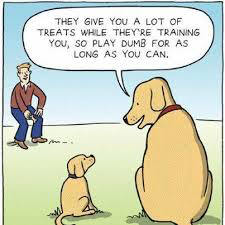
I get contacted by people all of the time saying things like:
"Any tips or tricks for getting my dog to stop doing x?"
"My dog barks at people, I have tried EVERYTHING to get him to stop but NOTHING works. Any advice?"
"My dog is mouthy, I correct him but it is not working…help"
It is difficult for a trainer, any trainer, to answer these types of questions. Without knowing your dog and seeing the dynamics that exist in your family we are really taking a shot in the dark. Most good trainers are very reluctant to give advice like that without a consult because without seeing what is going on, without knowing you and your dog, the “tips, advice, tricks” can go seriously wrong.
This is also the reason why I cringe when I hear people say “I watched a show on TV. The dog and it’s issues was identical to mine. I tried what was recommended but it did not work”.
It did not work because, your dog was not identical to the dog in the show, you were not identical to the owner, and often times, the little nuances and interactions that happen off camera are just as important as the interactions that happen while the camera is rolling.

Allow me give you two “tips” however that will NEVER steer you wrong. Please keep in mind, these tips are not pretty. They are not quick fixes. However, the good things in life very rarely are.
Tip Number One: Have Patience and Practice
Interact with your dog constantly. Challenge your dog’s brain. Challenge yourself to find new and fun ways to interact with your dog. The more you do this, the greater the development that occurs. Resist the urge to rush things. I have clients constantly say “I just want Fido to come when called”. When I ask how old Fido is, I get a response like…."he is six months old”. Trusting a six month old dog to come when called every time, especially around heavy distraction, is like trusting a two year old just learning to walk not to run away from mom and dad the first chance he gets.
It is not going to happen.
A reliable and effective recall around all types of distraction takes years to develop. You need to successfully work a recall a thousand times where you can control the training parameters before you start introducing big distractions. When you get to the distraction piece, you need to practice the recall another thousand times successfully throughout all types of distractions. You need to graduate your dog to these types of activities.
Have patience. If done right and you put the work in, your work will be rewarded.
Tip Number Two: Be Consistent
Basic psychology is basic psychology. It does not matter if it is dog or human. Too often even trainers hide causes of actions behind pseudo psycho babble like “dominance”, “pack structure” and “alpha” to describe rude and learned behaviours (for more on this, see dominance and the alpha dog).
I have stated it before in many of these blogs:
A dog only commits an action to get a desired reaction. If the action does not get the desired reaction, the dog will move to a different action until he finds one that gives him the desired reaction or until you can replace that desired reaction with something even more desired.
If your dog is jumping on people who come into your house, somewhere in the upbringing, the dog has learned jumping on people gives him the reaction that he wants…typically this is interaction with the visitors. If your dog is chasing your cat, the dog has learned that chasing the cat results in fun i.e. the cat tucking tail and running. For an owner trying to halt this behaviour, it is important to be able to interrupt the behaviour each and every time and teach an alternative desired behaviour that will get the dog the desired result or a result that the dog desires more then the learned one.
Again, neither of these “tricks” are quick fixes. Neither of these use any gimmicks. They do require time, patience, work and learning to PROPERLY COMMUNICATE with your dog. A consult with good quality trainer will help you out with this (for more on this subject refer to “finding the right trainer” and “a good trainer is". Completion of a good quality obedience course will help immeasurably. Time spent practicing and interacting with your dog every day is key. Opportunities to properly socialize your dog with both other dogs and people are so important.
All of these factors add up to time well spent. The rewards for both you and your dog will be enormous and invaluable.
Here is a flowchart which may help out:
